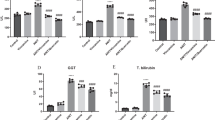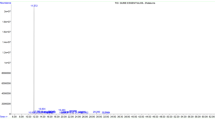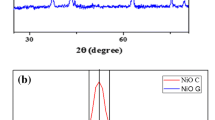Abstract
Agrochemicals are one the most significant sources of environmental pollution. Cytotoxicity and genotoxicity are the serious side effects of fungicide. In the current study, I have evaluated acute cytotoxicity and genotoxicity of triphenyltin (TPT) on human hepatic carcinoma (HepG2) cells and the ameliorating effect of ascorbic acid for 24 h. In this experiment, I have exposed HepG2 cells to ascorbic acids (50, 100, and 200 μM) simultaneously and 24 h prior triphenyltin (TPT, 400 ng/ml) exposure for 24 h to determine the protective effect of ascorbic acid by using MTT (3-(4,5-dimethylthiazol-2-yl)-2,5-diphenyltetrazolium bromide) and NRU (neutral red uptake) assays. Oxidative stress, such as intracellular reactive oxygen species and glutathione levels, was measured in HepG2 cells. The intracellular reactive oxygen species was evaluated using fluorescent probe DCFDA (6-carboxy-2′,7′ dichloro-dihydrofluorescein diacetate). Apoptosis and genotoxicity effects of TPT in HepG2 cells were determined using flow cytometry and comet assay. The result of these experiments showed that the TPT compound (400 ng/ml) induced cytotoxicity, oxidative stress and apoptosis, and DNA damage in HepG2 cells.Ascorbic acid reduced cytotoxicity, oxidative stress, apoptosis, and genotoxicity induced by TPT. Thus, ascorbic acid is a potent antioxidant, and it showed a significant protective effect against toxicity induced by TPT in HepG2 cells.







Similar content being viewed by others
References
Abdel-Daim MM, El-Ghoneimy A (2015) Synergistic protective effects of ceftriaxone and ascorbic acid against subacute deltamethrin-induced nephrotoxicity in rats. Ren Fail 37(2):297–304
Ali D, Nagpure NS, Kumar S, Kumar R, Kushwaha B (2008) Genotoxicity assessment of acute exposure of chlorpyrifos to freshwater fish Channa punctatus (Bloch) using micronucleus assay and alkaline single-cell gel electrophoresis. Chemosphere 71(10):1823–1831
Antes FG, Becker AG, Parodi TV, Clasen B, Lópes T, Loro VL, Baldisserotto B, Flores EM, Dressler VL (2013) Toxicity of triphenyltin hydroxide to fish. Arch Environ Contam Toxicol 65:733–741
Antizar LB (2008) Environmental levels, toxicity and human exposure to tributyltin (TBT)-contaminated marine environment. A Review. Environ Int 34:292–308
Ayala A, Muñoz MF, Argüelles S (2014) Lipid Peroxidation: Production, Metabolism, and Signaling Mechanisms of Malondialdehyde and 4-Hydroxy-2-Nonenal. Oxidative Med Cell Longev:360438 31 pages
Blokhina O, Virlainen E, Fagerstedt KV (2003) Antioxidants, oxidative damage and oxygen derivative stress: a review. Ann Bot 91:179–194
Borenfreund E, Puerner JA (1985) Toxicity determined in vitro by morphological alterations and neutral red absorption. Toxicol Lett 24(2–3):119–124
Bradford MM (1976) A rapid and sensitive method for the quantitation of microgram quantities of protein utilizing the principle of protein dye binding. Anal Biochem 72:248–254
Carraher CE Jr, Roner MR (2009) Organotin Polyethers as Biomaterials. Materials 2:1558–1598
Domico LM, Cooper KR, Bernard LP, Zeevalk GD (2007) Reactive oxygen species generation by the ethylene-bis-dithiocarbamate (EBDC) fungicide mancozeb and its contribution to neuronal toxicity in mesencephalic cells. Neurotoxicology. 28(6):1079–1091
Frijhoff J, Paul GW, Neven Z, Sean SD, Roland S, David C, Annie RK, Emma LT, Jeannette O, Tatjana R, Ana CG, Antonio C, Daniela W, Henrik EP, Tilman G, Harald HHWS, Pietro G (2015) Clinical Relevance of Biomarkers of Oxidative Stress. Antioxid Redox Signal 23(14):1144–1170
Gaetke LM, Chow CK (2003) Copper toxicity, oxidative stress and antioxidant nutrients. Toxicology 189:147–163
Gao F, Ma N, Zhou H, Wang Q, Zhang H, Wang P, Hou H, Wen H, Li L (2016) Zinc oxide nanoparticles-induced epigenetic change and G2/M arrest are associated with apoptosis in human epidermal keratinocytes. Int J Nanomedicine 11:3859–3874
Goldberg RN, Averbuj A, Cledón M, Luzzatto D, Sbarbati Nudelman N (2004) Search for triorganotins along the Mar del Plata (Argentina) marine coast: finding of tributyltin in egg capsules of a snail Adelomelon brasiliana (Lamarck, 1822) population showing imposex effects. Appl Organomet Chem 18:117–123
Kannan K, Tanabe S (2008) Global contamination by organotin compounds. In: Arai T et al (eds) Ecotoxicology of antifouling biocides. Springer-Verlag, New York, pp 39–60
Kannan K, Senthilkumar K, Giesy JP (1999) Occurrence of butyltin compounds in human blood. Environ Sci Technol 33:1776–1779
Lobo V, Patil A, Phatak A, Chandra N (2010) Free radicals, antioxidants and functional foods: Impact on human health. Pharmacogn Rev 4(8):118–126
Markovic Z, Trajkovic V (2008) Biomedical potential of the reactive oxygen species generation and quenching by fullerenes (C60). Biomaterials. 29(26):3561–3573
Moustafa, GG, Khalil, S., Hussein, M M., & Labib, M. The cytotoxic and ultrastructural perturbations of aluminum exposed Nile catfish with special reference to the mitigating effect of vitamin C. Life Sci J. 2012;9(4), 5198-5210
Packer L, Fuchs J (1997) Vitamin C in health and disease. Marcel Dekker Inc., New York
Singh NP, McCoy MT, Tice RR, Schneider EL (1988) A simple technique for quantitation of low levels of DNA damage in individual cells. Exp Cell Res 175:184–191
Sousa A, Genio L, Mendo S, Barroso CM. Comparison of the 1429 acute toxicity of tributyltin and copper to veliger larvae of 1430 Nassarius reticulatus (L.). Appl Organomet Chem 2005; 19(3): 1431 324–328
Sousa ACA, Pastorinho MR, Takahashi S (2013) History on organotin compounds, from snails to humans. Environ Chem Lett 12:117–137
Susin SA, Zamzami N, Kroemer G (1998) Mitochondria as regulators of apoptosis: doubt no more. Biochim Biophys Acta 1366(1-2):151–165
Yuan J, Murrell GAC, Trickett A, Wang MX (2003) Involvement of cytochrome c release and caspase-3 activation in the oxidative stress-induced apoptosis in human tendon fibroblasts. Biochim Biophys Acta 1641(1):35–41
Funding
This work was funded by the Supporting Project number (RSP-2019/140), King Saud University, Riyadh, Saudi Arabia.
Author information
Authors and Affiliations
Corresponding author
Additional information
Responsible editor: Mohamed M. Abdel-Daim
Publisher’s note
Springer Nature remains neutral with regard to jurisdictional claims in published maps and institutional affiliations.
Rights and permissions
About this article
Cite this article
Alkahtane, A.A. Protective potency of ascorbic acid supplementation against cytotoxicity and DNA fragmentation induced by triphenyltin on human liver carcinoma cells. Environ Sci Pollut Res 27, 28890–28898 (2020). https://doi.org/10.1007/s11356-020-08821-1
Received:
Accepted:
Published:
Issue Date:
DOI: https://doi.org/10.1007/s11356-020-08821-1




